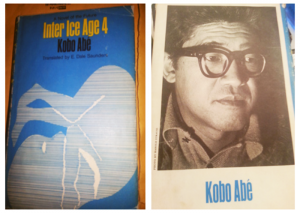
I happened upon this title when a friend posted an article on Facebook about literary authors that had made forays into science fiction. I perused the list with mild disinterest until I came upon one title written by Kobo Abe. I’ve always had a thing for Japanese science fiction and since I’d never heard of this book I decided to investigate. It took little more than reading the synopsis for me to make up my mind. The concept was a definite hook for me. But there were other factors involved in my decision-making process as well. After making a few phone calls to local bookstores and doing a couple of searches online, I discovered that the book was out of print and that the single run of the book was actually a translation. When you add this to the fact that it might have made for an exciting treasure hunt for lost volumes, I couldn’t resist. However, my excitement was quickly deflated when I found the book on Amazon, for four US dollars in a matter of minutes. The arrival of the book a few days later did much to renew my enthusiasm. It’s severely flaking dust jacket, liver-spotted pages, and ubiquitous smell of public library stacks was reminiscent of my days as a child spent wandering said institutions in search of entertainment.
Kobo Abe’s “Inter Ice Age 4” is a novel about the impending doom of humanity as a result of melting polar ice caps. The main character is a scientist who has created a machine that can predict the future. He and his team stumble upon a conspiracy surrounding the coming disaster indirectly while attempting to innocuously test the computer’s predictive abilities. The New York Times called this novel “Abe’s most radical work to date.” While it is unclear if this snippet from a review is positive or negative I can see why it might be considered so. Considering that the book was published in 1958 and translated some ten years later, Abe takes two politically charged issues and manages to spin a fantastic story without coming off ham-handed. The issue of abortion and climate change are expertly woven together and clothed in some excellent prose. One might call that prophetic. Or they might just call it good writing.
I can’t close out this short review without discussing some of the elements of the story itself. The computer in Inter Ice Age 4 is presented as much a character as a simple plot device. Some people might feel tempted to make a comparison between this story and Phillip K. Dick’s “Paycheck”, about another fortune-telling computer written in 1952. One should avoid this temptation at all costs so as not to look foolish in the later chapters. The computer in “Inter Ice Age 4” makes several appearances (as itself), and even manifests itself as others. However, the most interesting thing about this machine, is how charmingly anachronistic it is. IT USES PUNCH CARDS. On the one hand, the use of punch cards makes the whole thing horribly laughable, but it has other strange abilities that simply should never be attributed to computers. Despite this odd fact I rather enjoyed the presence of this particular element in the story. It was a bit like having an old and eccentric aunt photobombing the entire novel.
Finally, it should be noted that this is not the best translation I have ever seen. It was competently done and the translator even captured most of the nuances of literary description in the conversion from Japanese to English. But there were times when I felt it was repetitive and the translator defaulted too often to common use phrases. I couldn’t shake the sense that it was a barrier between myself and the writers. The cracks in the translation were far and few between but present enough to set a tone for the whole work. Certainly not enough to warrant skipping the book altogether. The prose itself is beautifully written and well balanced in terms of description versus exposition. I highly recommend this novel, though I will caution that it is not for everyone. Please keep in mind that the book is out of print and while I had no trouble getting it on Amazon, not everyone will necessarily have the same experience.
Here is some additional information about the author:
Abe was born in Kita, Tokyo and grew up in Mukden (now Shenyang) in Manchuria. His father was a physician who taught at a local medical college. Abe returned to Japan in 1941 and began studies at Tokyo Imperial University in 1943. He graduated in 1948 with a medical degree, on the condition that he would not practice. Having failed his exam several times, and already a successful author, this was attached to cultural notions of “saving face.”
He was first published as a poet in 1947 with Mumei-shishū (“Poems of an unknown poet”) and as a novelist the following year with Owarishi michi no shirube ni (“The Road Sign at the End of the Street”), which established his reputation. Though he did much work as an avant-garde novelist and playwright, it was not until the publication of The Woman in the Dunes in 1962 that he won widespread international acclaim.
In the 1960s, he collaborated with Japanese director Hiroshi Teshigahara in the film adaptations of The Pitfall, Woman in the Dunes, The Face of Another and The Ruined Map. In 1973, he founded an acting studio in Tokyo, where he trained performers and directed plays. He was elected a Foreign Honorary Member of the American Academy of Arts and Sciences in 1977.[4]
Among the honors bestowed on him were the Akutagawa Prize in 1951 for The Crime of S. Karuma, the Yomiuri Prize in 1962 for Woman in the Dunes, and the Tanizaki Prize in 1967 for the play Friends. Kenzaburō Ōe stated that Abe deserved the Nobel Prize in Literature, which he himself had won (Abe was nominated multiple times).

